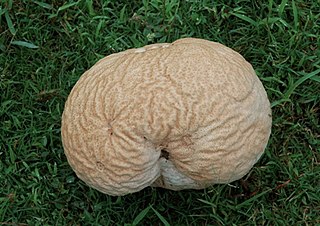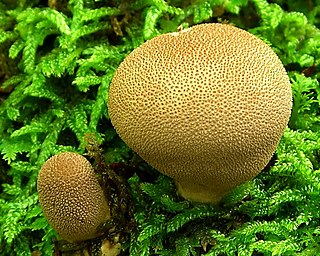
Puffballs are a type of fungus featuring a ball-shaped fruit body that bursts on contact or impact, releasing a cloud of dust-like spores into the surrounding area. Puffballs belong to the division Basidiomycota and encompass several genera, including Calvatia, Calbovista and Lycoperdon. The puffballs were previously treated as a taxonomic group called the Gasteromycetes or Gasteromycetidae, but they are now known to be a polyphyletic assemblage.

Lepiota is a genus of gilled mushrooms in the family Agaricaceae. All Lepiota species are ground-dwelling saprotrophs with a preference for rich, calcareous soils. Basidiocarps are agaricoid with whitish spores, typically with scaly caps and a ring on the stipe. Around 400 species of Lepiota are currently recognized worldwide. Many species are poisonous, some lethally so.

The Agaricaceae are a family of basidiomycete fungi and include the genus Agaricus, as well as basidiomycetes previously classified in the families Tulostomataceae, Lepiotaceae, and Lycoperdaceae.

Coprinus is a small genus of mushroom-forming fungi consisting of Coprinus comatus—the shaggy ink cap (British) or shaggy mane (American)—and several of its close relatives. Until 2001, Coprinus was a large genus consisting of all agaric species in which the lamellae autodigested to release their spores. The black ink-like liquid this creates gave these species their common name "ink cap" (British) or "inky cap" (American).

The Lycoperdales are a now outdated order of fungi. The order included some well-known types such as the giant puffball, the earthstars, and other tuberous fungi. They were defined as having epigeous basidiomes, a hymenium present, one to three layers in the peridium, powdery gleba, and brown spores.

Calvatia is a genus of puffball mushrooms that includes the giant puffball C. gigantea. It was formerly classified within the now-obsolete order Lycoperdales, which, following a restructuring of fungal taxonomy brought about by molecular phylogeny, has been split; the puffballs, Calvatia spp. are now placed in the family Lycoperdaceae of the order Agaricales.

Lycoperdon perlatum, popularly known as the common puffball, warted puffball, gem-studded puffball or devil's snuff-box, is a species of puffball fungus in the family Agaricaceae. A widespread species with a cosmopolitan distribution, it is a medium-sized puffball with a round fruit body tapering to a wide stalk, and dimensions of 1.5 to 6 cm wide by 3 to 10 cm tall. It is off-white with a top covered in short spiny bumps or "jewels", which are easily rubbed off to leave a netlike pattern on the surface. When mature it becomes brown, and a hole in the top opens to release spores in a burst when the body is compressed by touch or falling raindrops.

The Cortinariaceae are a large family of gilled mushrooms found worldwide, containing over 2100 species. The family takes its name from its largest genus, the varied species of the genus Cortinarius. Many genera formerly in the Cortinariaceae have been placed in various other families, including Hymenogastraceae, Inocybaceae and Bolbitiaceae.

Calvatia craniiformis, commonly known as the brain puffball or the skull-shaped puffball, is a species of puffball fungus in the family Agaricaceae. It is found in Asia, Australia, and North America, where it grows on the ground in open woods. Its name, derived from the same Latin root as cranium, alludes to its resemblance to an animal's brain. The skull-shaped fruit body is 8–20 cm (3–8 in) broad by 6–20 cm (2–8 in) tall and white to tan. Initially smooth, the skin (peridium) develops wrinkles and folds as it matures, cracking and flaking with age. The peridium eventually sloughs away, exposing a powdery yellow-brown to greenish-yellow spore mass. The puffball is edible when the gleba is still white and firm, before it matures to become yellow-brown and powdery. Mature specimens have been used in the traditional or folk medicines of China, Japan, and the Ojibwe as a hemostatic or wound dressing agent. Several bioactive compounds have been isolated and identified from the brain puffball.

Bovista is a genus of fungi commonly known as the true puffballs. It was formerly classified within the now-obsolete order Lycoperdales, which, following a restructuring of fungal taxonomy brought about by molecular phylogeny, has been split; the species of Bovista are now placed in the family Agaricaceae of the order Agaricales. Bovista species have a collectively widespread distribution, and are found largely in temperate regions of the world. Various species have historically been used in homeopathic preparations.

Handkea utriformis, synonymous with Lycoperdon utriforme, Lycoperdon caelatum or Calvatia utriformis, is a species of the puffball family Lycoperdaceae. A rather large mushroom, it may reach dimensions of up to 25 cm (10 in) broad by 20 cm (8 in) tall. It is commonly known as the mosaic puffball, a reference to the polygonal-shaped segments the outer surface of the fruiting body develops as it matures. Widespread in northern temperate zones, it is found frequently on pastures and sandy heaths, and is edible when young. H. utriformis has antibiotic activity against a number of bacteria, and can bioaccumulate the trace metals copper and zinc to relatively high concentrations.

Handkea is a genus of puffball mushrooms in the family Agaricaceae. In 1989, German mycologist Hanns Kreisel described the genus Handkea to include species of Calvatia with distinct microscopic features, including a unique type of capillitium, with curvy slits instead of the usual pores. Although accepted by some authors, the genus concept has been rejected by others.

Arachnion is a genus of gasteroid fungi in the family Agaricaceae.

Calbovista is a fungal genus containing the single species Calbovista subsculpta, commonly known as the sculptured puffball, sculptured giant puffball, and warted giant puffball. It is a common puffball of the Rocky Mountains and Pacific Coast ranges of western North America. The puffball is more or less round with a diameter of up to 15 cm (6 in), white becoming brownish in age, and covered with shallow pyramid-shaped plates or scales. It fruits singly or in groups along roads and in open woods at high elevations, from summer to autumn.

Mycenastrum is a fungal genus in the family Agaricaceae. The genus is monotypic, containing one widely distributed species, Mycenastrum corium, known by various common names: the giant pasture puffball, leathery puffball, or tough puffball. The roughly spherical to turnip-shaped puffball-like fruit bodies grow to a diameter of 6–24 cm (2–9 in). Initially covered by a thick, felted, whitish layer, the puffballs develop a characteristic checkered skin (peridium) in age. When the internal spore mass, the gleba, is firm and white, the puffball is edible, although some individuals may suffer mild gastrointestinal symptoms after eating it. As the spores mature, the gleba turns first yellowish then purplish brown. Spores are released when the peridium eventually splits open into irregularly shaped sections. Microscopically, the gleba consists of spherical, dark brown spores with rounded bumps on their surfaces, and a capillitium—intricately branched fibers that form long thorn-like spines. The puffball grows on or in the ground in prairie or desert habitats. Although widely distributed, it is not commonly encountered. Mycenastrum corium is a threatened species in Europe.

Lycoperdon echinatum, commonly known as the spiny puffball or the spring puffball, is a type of puffball mushroom in the family Agaricaceae. The saprobic species has been found in Africa, Europe, Central America, and North America, where it grows on soil in deciduous woods, glades, and pastures. It has been proposed that North American specimens be considered a separate species, Lycoperdon americanum, but this suggestion has not been followed by most authors. Molecular analysis indicates that L. echinatum is closely related to the puffball genus Handkea.

Handkea excipuliformis, commonly known as the pestle puffball or long-stemmed puffball, is a species of the family Agaricaceae. A rather large puffball, it may reach dimensions of up to 15 cm (5.9 in) broad by 25 cm (9.8 in) tall. Widespread in northern temperate zones, it is found frequently on pastures and sandy heaths.

Morganella is a genus of puffball fungi in the family Agaricaceae. The genus name honors American botanist Andrew Price Morgan (1836–1907). The widely distributed genus is prevalent in tropical areas. A 2008 estimate placed nine species in Morganella, but several new species have since been described.

Lycoperdon subincarnatum is a type of puffball mushroom in the genus Lycoperdon. It was first officially described in 1872 by American mycologist Charles Horton Peck. The puffball is found in North America and China.

Vascellum is a genus of puffball fungi in the family Agaricaceae. The genus was defined by Czech mycologist František Šmarda in 1958.


















